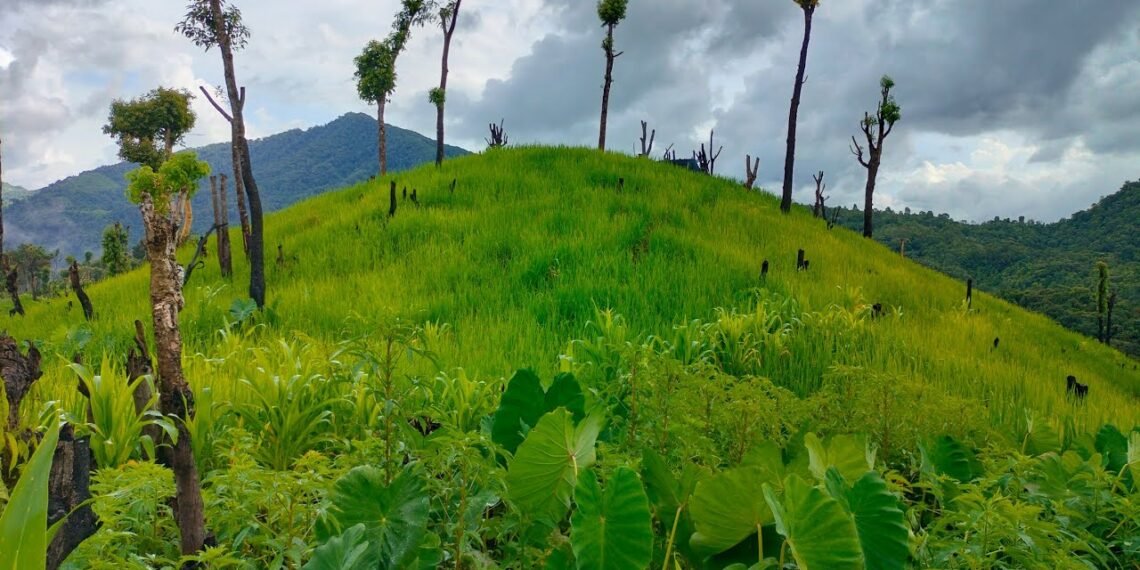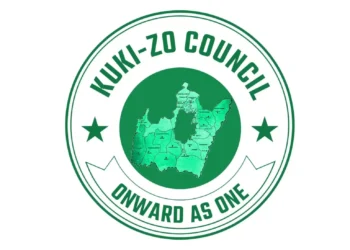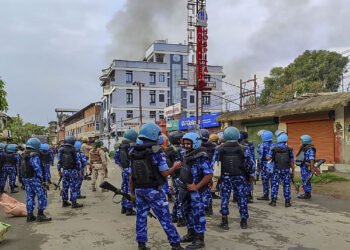The recent clash in a Liangmai village in Manipur’s Kangpokpi district has once again brought the simmering tensions between the Kuki and Liangmai Naga communities into sharp focus. This incident, occurring on April 5, 2025, involved the alleged kidnapping of a village chief, chairman, and secretary from Konsaram Naga village by suspected Kuki militants, sparking outrage and escalating ethnic strife in the region.
A subsequent war of words between the two communities has further inflamed the situation, with the Young Kuki issuing a strongly worded statement on April 7, 2025, in response to a press release by Global Liangmai on the same day. The question of responsibility for this clash, as well as the historical ownership of the disputed land, is deeply rooted in Manipur’s complex ethnic history, colonial legacies, and ongoing struggles over territory and identity. This article explores these dimensions to shed light on the conflict.
ALSO READ: Young Kuki Slams Global Liangmai’s Claims in Land Dispute
ALSO READ: Meitei Body Condemns Attack on Naga Leaders, Alleges Land Grab
The Incident: What Happened?
On April 5, 2025, tension flared in Kangpokpi district when suspected Kuki militants reportedly attacked Konsaram Naga village around 12:15 PM. According to officials and the Konsakhul village authority, the assailants kidnapped three key figures—the village chief, chairman, and secretary—while villagers were engaged in agricultural and construction activities. The Konsakhul authority condemned the attack as “premeditated,” accusing the militants of disguising themselves as civilians or volunteers. They further alleged that an Assistant Sub-Inspector, Kamgin Veiphei, facilitated the attack, demanding his suspension and investigation. The incident has heightened tensions between the Kukis and Liangmai Nagas, a subgroup of the broader Naga community, in an already volatile region marked by ethnic divisions.
However, the Young Kuki, representing a section of the Kuki community, has challenged this narrative. In a statement issued on April 7, 2025, they highlighted a specific incident on April 2, 2025, where the Chief of the Liangmai village allegedly disregarded an official curfew imposed by the District Commissioner. The curfew, intended to prevent further confrontations following earlier clashes over the disputed land, was defied by individuals from the Liangmai community, who, according to the Young Kuki, attempted to disrupt public peace by forcibly carrying out activities on the contested land.
ALSO READ: Naga Students Demand AFSPA Repeal, Target Indian Army
“The accusations of a ‘barbaric attack’ are unfounded and misrepresent the reality of the situation,” the Young Kuki stated, emphasizing that their response on April 5 was a necessary measure to protect their rights and maintain order.
Who Is Responsible?
Determining responsibility for the clash is challenging due to the lack of conclusive evidence and the polarized narratives from both sides. The Konsakhul village authority explicitly points to Kuki militants as the perpetrators, framing the attack as an aggressive incursion into Liangmai Naga territory. This aligns with broader accusations from Naga groups that Kukis have encroached on their ancestral lands, a grievance that has fueled decades of conflict.
The Young Kuki’s statement, however, provides a counter-narrative. In response
Manipur: In light of the recent press release issued by Global Liangmai on 7th April 2025 we the Young Kuki are compelled to issue a statement addressing the baseless and misleading claims made regarding the ongoing land ownership dispute in Kangpokpi District.
@ukhrultimes pic.twitter.com/NyJ1YNFFnv— Nampi Romeo Kuki (@Nampiromeokuki) April 7, 2025
to a press release by Global Liangmai on April 7, 2025, which accused the Kuki community of carrying out a “barbaric attack” on Liangmai villagers, the Young Kuki categorically denied these allegations. They asserted that their actions were purely defensive, a response to alleged encroachments by Liangmai villagers on disputed land. They further criticized the Global Liangmai for citing historical anecdotes without evidence, such as a supposed 1922 document allegedly written with a ballpoint pen—a technology not invented at the time—calling into question the authenticity of Liangmai claims. The Young Kuki also took issue with inflammatory language in the Global Liangmai’s release, including threats of violence and references to Kukis “observing another Black Day,” which they labeled as hate speech and a direct act of aggression.
The Young Kuki’s mention of the April 2 incident adds another layer to the conflict. They claim that the Liangmai community’s defiance of the curfew—intended to de-escalate tensions—provoked the subsequent clash, framing the April 5 attack as a reaction to Liangmai actions. Posts on X have echoed similar sentiments, with some claiming that a Liangmai individual confessed to encroaching on Kuki-owned land, though such claims remain anecdotal and unverified. Conversely, the Liangmai and Naga groups argue that the curfew, imposed by the Kangpokpi district magistrate, restricted their movements while allowing Kuki militants to operate, a point of contention that the Konsakhul authority has also raised.
The immediate trigger appears to be a localized dispute over land use or settlement rights, but the clash cannot be divorced from the broader ethnic and political dynamics in Manipur. Both communities have militant factions with a history of violence, and the state’s fragile security apparatus has struggled to maintain order amid these tensions. The Young Kuki called on the Liangmai community to avoid escalating the issue into a broader communal conflict, urging all parties to refrain from actions that undermine peace and harmony. They expressed hope for the speedy recovery of the injured individuals and encouraged collaborative efforts to maintain stability in the region. However, the mutual accusations and lack of trust suggest that reconciliation remains elusive.
Historical Ownership of the Disputed Land
The question of who historically owns the disputed land in Kangpokpi and surrounding areas is central to understanding the clash. Manipur’s ethnic landscape is a patchwork of tribal territories shaped by migrations, colonial policies, and post-independence power struggles. The Kukis and Nagas, including the Liangmai subgroup, have long contested land ownership in the state’s hill regions, with competing historical narratives.
Naga Claims: The Liangmai Nagas, part of the Zeliangrong Naga group, assert that the northern hills of Manipur, including areas like Kangpokpi and Senapati, are their ancestral homelands. This claim is supported by oral traditions and some colonial records, which indicate that Naga tribes were predominant in the northern hills when the British established their protectorate over Manipur in the 19th century. The United Naga Council (UNC) and other Naga bodies argue that Kukis are relatively recent arrivals, migrating into these areas from Myanmar and Mizoram starting in the 18th and 19th centuries under British encouragement. Census data from 1951–1961, for instance, shows a decline in Naga villages in northern subdivisions like Ukhrul and Tamenglong, alongside an increase in Kuki settlements in southern districts.
Kuki Claims: The Kukis, including the Thadou and other Chin-related tribes, counter that they have a longstanding presence in Manipur’s hills, predating or coinciding with Naga dominance in certain areas. Historical accounts, such as those from British officials like T.H. Lewin in 1870, describe the Kukis as a “powerful and independent” people extending across the hills of Manipur and beyond. Kuki narratives often emphasize that they settled in northern hills with Naga consent, sometimes in exchange for protection, and that their land rights were later contested as Naga nationalism grew.
The Young Kuki, in their statement, urged the Liangmai to reevaluate claims that the Liangmai granted land to the Vaiphei tribe of the Kuki community in 1920, citing evidence tax receipts from 1917–1919, 1919–1921, and 1931–1932, available through the Kuki Reformation Forum (KReF). They argue that the Kuki community has a documented presence in the Manipur Durbar, challenging the narrative of recent settlement. The Kuki National Organisation (KNO) and other groups assert that the hills, including parts of Kangpokpi, form part of their historical “Kukiland,” a claim that overlaps with the Naga vision of “Nagalim” or Greater Nagaland.
Post-Independence Dynamics: After India’s independence, the Naga push for integration with Nagaland and the Kuki demand for a separate homeland intensified land disputes. The Naga-Kuki clashes of 1992–1998, which killed over 1,000 people and displaced tens of thousands, were largely driven by these overlapping territorial ambitions. In Kangpokpi, a district carved out of Senapati in 2016, the mix of Liangmai Naga and Kuki populations has made it a flashpoint for such conflicts. Naga groups like the Liangmai Naga Council (LNC) argue that Kuki settlements in these areas are recent and illegitimate, while Kukis point to their established villages and cultural ties to the land.
Analysis: A Contested Legacy
Historically, neither the Kukis nor the Liangmai Nagas can claim uncontested ownership of the disputed land in a strict sense. The Liangmai Nagas likely held sway over much of the northern hills before significant Kuki migration, but the latter’s arrival—sanctioned by colonial powers—established a lasting presence that cannot be dismissed as mere intrusion. The Young Kuki’s reference to tax receipts and historical records challenges the Liangmai narrative of exclusive ownership, while the Liangmai’s reliance on oral traditions and colonial-era demographics underscores their deep-rooted connection to the land. The land’s ownership is thus a product of layered histories: indigenous Naga habitation, Kuki migration and settlement, and British manipulation of ethnic boundaries.
The April 5 clash reflects this unresolved tension, exacerbated by the events of April 2. If Kuki militants indeed attacked Konsaram village, it may stem from a perceived need to assert control over territory they view as rightfully theirs, especially if they believed the Liangmai were violating the curfew to encroach on disputed land. Conversely, Liangmai resistance to such actions underscores their determination to protect what they see as ancestral land, with the curfew perceived as a tool that hindered their ability to defend themselves. The lack of clear legal titles, compounded by weak state mechanisms for adjudicating tribal land disputes, perpetuates this cycle of violence.
The Liangmai village clash in Manipur is a tragic symptom of deeper ethnic and territorial rivalries between the Kukis and Liangmai Nagas. Responsibility cannot be pinned solely on one group without further evidence, but the incident highlights the roles of militant factions, historical grievances, and administrative lapses. The Young Kuki’s statement underscores the complexity of the conflict, framing their actions as defensive while accusing the Liangmai of provocation and misrepresentation. As for historical ownership, the land in question bears the imprint of both Naga and Kuki histories, with neither claim fully eclipsing the other. Resolving such conflicts requires not just security measures but a nuanced approach to land rights, one that acknowledges Manipur’s complex past and seeks reconciliation over retribution. Until then, Kangpokpi and similar regions will remain tinderboxes of ethnic strife.













